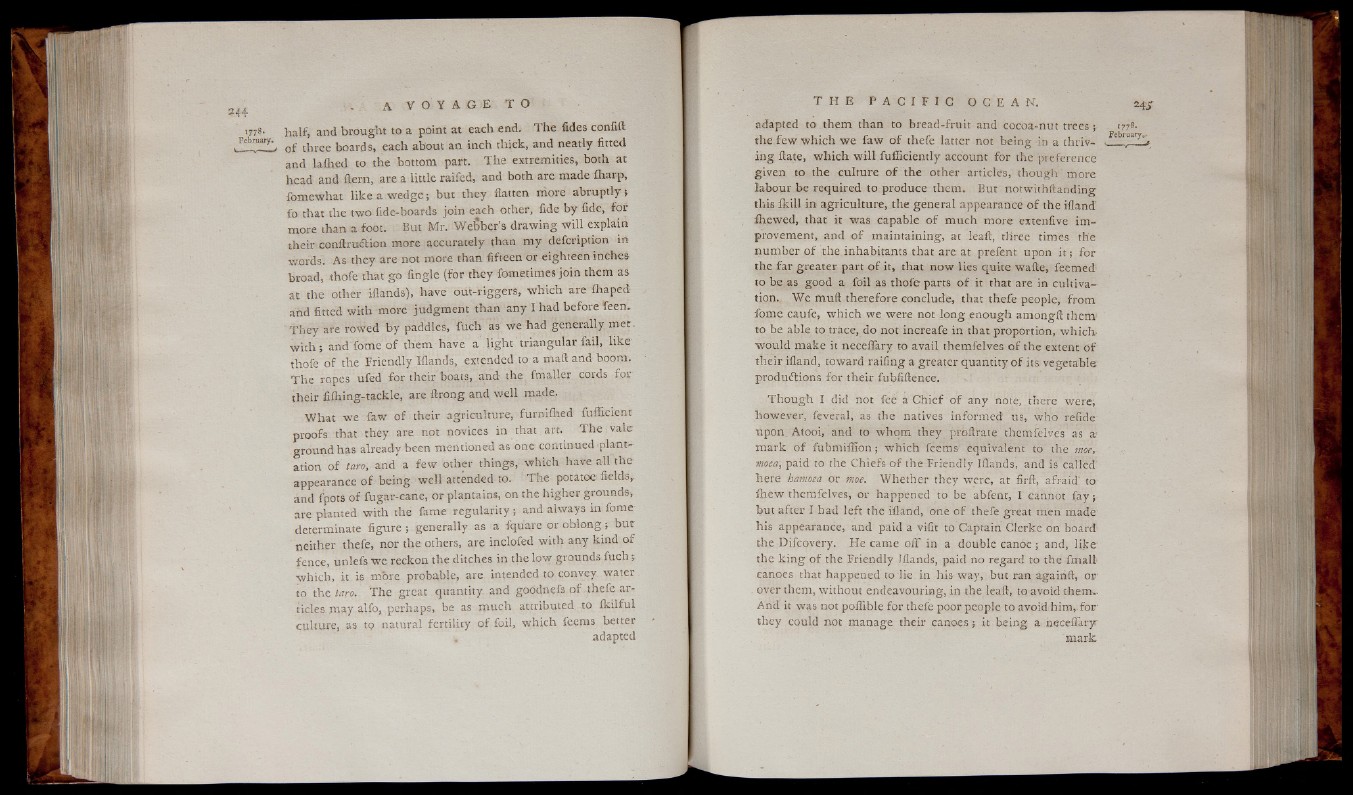
1778. half, and brought to a point at each end. T he fides confift
. Febr-uary‘ . 0f three boards, each about an inch thick, and neatly fitted
and laihed to the bottom part. T he extremities, both at
head and ftern, are a little raifed, and both are made iharp,
fomewhat lik e a w e d g e ; but they flatten more a b ru p t ly ;
fo that the two fide-boards join each other, fide b y fide, for
more than a foot. But Mr. WeSber’s drawing w ill explain
their conftruition more accurately than m y defcription in
words; As they are not more than fifteen or eighteen inches
broad, thofe that go fingle (for they fometimes join them as
at the other iilands), have out-riggers, w h ich are fhaped
and fitted with more ju d gm en t than any I had before Teen.
T h e y are rowed by paddles, fuch as w e had generally met.
w i t h y and fome o f them have a' ligh t triangular fail, lik e
thofe o f the Friendly Iflands, extended to a mail and boom.
T h e ropes ufed fo r their boats, and the fmaller cords for
their fiihing-tackle, are ftrong and w e ll made.
What w e faw o f their agriculture, furnifhed fufficient
proofs that they are not novices in that art. T he v a le
ground has already been mentioned as one continued plantation
o f taro, and a few other things, which have all the
appearance o f be in g w e ll attended to. T he potatoe fields,
and fpots o f fugar-cane, or plantains, on the higher grounds,
are planted with the fame regu larity ; and always in fome-
determinate figure ; generally as a fquare or o b lo n g ; bur
neither thefe, nor the others, are inclofed with any kind o f
fence, unlefs w e reckon the ditches in the low grounds fuch t
which, it is more probable, are intended to convey water
to the taro. T he great quantity and goodnefs o f thefe articles
may alfo, perhaps, be as much attributed to fk ilfu l
culture, as to natural fertility o f foil, w hich feems better
adapted
adapted to them than to bread-fruit and cocoa-nut t r e e s ; 1778-
the few which w e faw o f thefe latter not being in a thriv- . Febru3ry--j
in g ftate, w h ich w ill fufficiently account for the preference
given to the culture o f the other articles, though more
labour be required to produce them. But notwithftanding
this lk ill in agriculture, the general appearance o f the ifland'
fhewed, that it was capable o f much more exteniive improvement,
and o f maintaining, at leaft, three times the
number o f the inhabitants that are at prefent upon i t ; for
the far greater part o f it, that now lies quite wafte, feemed
to be as good a foil as thofe parts o f it that are in cultivation.
We muft therefore conclude, that thefe people, from
fome caufe, which we were not long enough amongft them
to be able to trace, do not increafe in that proportion, w hich
would make it neceffary to avail themfelves o f the extent o f
their ifland, toward railing a greater quantity o f its. vegetable
productions for their fubfiftence.
T h o u gh I did not fee a C h ief o f any note, there were;
however, feveral, as the natives informed us, who refide'
upon Atooi, and to whom, they proftrate themfelves as p
ma rk o f fu bm illion ; w hich feems equivalent to the moe,
moea, paid to the Chiefs o f the Friendly Iflands, and is called
here hamoea or moe. Whether they were, at firft, afraid' -to
lh ew themfelves, or happened to be abfent, I cannot f a y ;
but after I had left the ifland, one o f thefe great men made'
his appearance, and paid a vilit to Captain Clerke on board
the Difcovery. He came o ff in a double can o e ; and, like*
the k in g o f the Friendly Iflands, paid no regard to the fm alf
canoes that happened to lie in his way, but ran agairift, or
over them, without endeavouring, in the leaft, to avoid them-
And it was not poflible for thefe poor people to avoid him, for'
they could not manage their c an o e s ; it being a neceflary
mark.